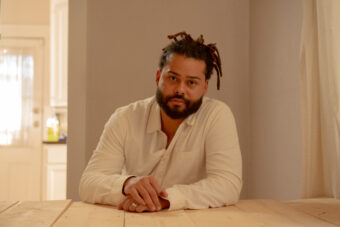As the early arrivers assemble outside London’s Electric Ballroom for a pre-show meet-and-greet, the energy spikes a bit when one familiar face makes his appearance. Were you walking past, seeing the smiles and hoots and enthusiasm, you would understandably figure that this guy was part of the attraction.
Alas, no. It’s Phil. Panama Phil, as he’s called. Is he with the band? That part is complicated.
During the last night of The Hold Steady’s 2019 four-show run at Brooklyn Bowl in New York, a series of year-closing engagements that have been known as “Massive Nights” since they began in 2016, frontman Craig Finn mentioned that there were seven people who had been to all 23 Hold Steady shows that year. Six of them were on stage.
The other was Phil, a 64-year-old Tennesseean who first saw The Hold Steady live in 2018 and has barely missed a gig since. The shows are loud and beery and physical and sweaty, but Panama Phil sometimes brings along his wife, or his 30-year-old son and future daughter-in-law, and throughout the long weekends, he’s one of a number of fans who have become semi-celebrities in the room, some of them as recognizable as the musicians, themselves. But he’s also a key part in understanding a band and its unique, co-dependent bond with its tight fan community that nurtures both sides.

Also Read
The Best Albums of 2023 (So Far)
//
In London for a series of three shows early this month (a yearly run known as “The Weekender,”) Finn, now 48, hearkened back to December 2014 when the band was finishing up a 100-plus date international tour in support of Teeth Dreams. The concerts were still lively and fun, but the makeup was different. Franz Nicolay and his keyboard had departed the stage in early 2010, and after nods in a few different directions, the group brought in Steve Selvidge to serve as a second guitarist, alongside Tad Kubler. When the band was approached about doing four shows at Toronto’s Horseshoe Tavern, the idea of spending that much time at one stop seemed pretty hard to conceive.
But when Finn and the guys got to Canada, stripped of the here-today-gone-tomorrow tour bus existence, they found themselves exploring more, relaxing more and feeling rejuvenated. Committed to getting to spend more time on his solo work while still keeping his primary band afloat, Finn realized that the old touring paradigm didn’t work anymore for a band and a fanbase all staring down their mid-40s and beyond. If there was going to be an obvious difference in the energy on a Friday night show in Chicago from a Wednesday night in a smaller locale a state or two away, why not just get rid of the latter entirely?
What if, instead of going where the fans were, they set up camp in a few major cities a few times a year and encouraged fans to come to them?
In 2016, Nicolay returned to the band for the 10th anniversary of Boys and Girls in America, joining Bobby Drake on drums, Kubler and Selvidge on guitar, Galen Polivka on bass and Finn at the wheel. That December, the group played four shows in Brooklyn, then three the next summer in Chicago. By 2018, they had expanded the scope a bit more with multi-show runs in cities such as San Francisco, Toronto, Philadelphia and Finn’s hometown of Minneapolis. The model expanded in 2019 and will see them play 22 shows in eight different cities in 2020 (the band is even organizing a bus trip for fans wishing to attend both a June 5 show in Nashville and the June 6 Atlanta performance). It isn’t really a tour; it’s eight stand-alone vacations.
//
Kevin from Chicago has been to something like 50 or 60 Hold Steady shows, and he’s hanging at the soundcheck meet-and-greet before Friday’s opening night of “The Weekender 3.” “It’s almost a story,” he says. “There’s the arc of the stories that Craig tells, and there’s the arc of the weekend.” Next month, in Minneapolis, Kevin’s wife will come to one of the shows. The rest of the time, she’ll explore a fun and different city. Everyone wins.
“The thing is, it is a proper tour,” says Morris, a Brooklyn transplant living in Brixton. “They’re just not playing mid-week shows. It’s obvious that they’re happier doing this than they were being on tour in 2014.”
Whether in the venue before the show or somewhere about town, the weekends provide a sense of fullness to the experience. “If I’m at a one-night show, sometimes I don’t really talk to anybody if I go there alone,” says Kasper, who traveled in from Odense in central Denmark. “But when I’m here for three nights, I know I’m going to see the same people. I know I’m going to put in the effort to really talk to people and meet people.”
Each Hold Steady show has its own energy, but the intensity baseline is pretty high. The nights lean on rhythms of confetti-throwing joy that become standard after a while, the way that “Constructive Summer” usually flows right into ”Hot Soft Light,” or that “Massive Nights“ will always end with a slightly drawn-out stutter from Finn that then transitions seamlessly to one of the regular main-set-closing bangers — “Slapped Actress,” “How A Resurrection Really Feels” or “Southtown Girls.” On these three nights in London, they played a different new song each night and offered some wink-wink hints that there might be a new album dropping, quick on the heels on 2019’s well-received Thrashing Thru the Passion. But even with never-before-played material, “The Weekender” shows never felt precious because Hold Steady gigs aren’t about wowing fans with something terribly new or different; they’re about the connectivity of the familiar. The fans know to clap in rhythm with barely any direction from Finn, and they even know the difference between a double-clap (“Most People Are DJs”), and a double-single combo (”Sequestered in Memphis”).
It’s the sense of belonging, then, that keeps the shows feeling so fresh. “If it weren’t for the community,” says Panama Phil, “I probably would not be that passionate about just hearing the same music over and over.”
When he’s not spitting strangely poetic, literary, marathon-a-minute lyrics about anything from drug deals (and worse) in back alleys to a girl putting $900 on the fifth horse in the sixth race, Finn makes a point to acknowledge the fans who have traveled from all over the world to hit these London shows. “To see everyone meeting each other, it’s an incredible feeling,” he says from the stage near the close of Night 3. “It’s what we dreamed about when we started this band.” It might seem rote for a musician winding down a night of songs, but here, it’s easy to see who he’s talking to. “They want to connect, and it’s obvious” Phil says.
This is a space for die-hards, for people ready to experience a call-and-response orgy that will last about 100 minutes and burn the calories of your typical 10K. The mob that fills the room is perfectly able to sing from memory the directions to a Rainbow Foods and Party City in the northeast part of Minneapolis, to say nothing of some landmarks in Ybor City, Florida, where they throw such killer parties.
“You get the feeling that people are there for the same reason that you are, to sing along as loud as you can, jump into people, have a good fucking time,” says Kasper. “And when I’m at the front of the show, and I’m jumping into people, we’re all singing along, looking at each other in the eyes with a recognizing smile. I know this. You know this. We have a connection, even if you don’t know them.”
Morris has been to more than 30 Hold Steady shows, but he can’t plan his year around the band’s residencies in the way that Panama Phil can, and certainly won’t be in Melbourne, Australia, when the band goes down under in May. But he enjoys the way the contained nature of each small adventure fulfills the arc that Kevin mentioned. “Each of these residencies is separate from a larger narrative,” Morris says. “They exist on their own. When you go follow a band on tour — I like to see Phish a lot — you have to hit the next show, you have to hit the next show, you have to hit the next show. With a residency like this, you can go to the one residency you’re going to this summer and feel complete.”
//
In 2016, after departing the band and traveling around the world as a solo act, Nicolay published The Humorless Ladies of Border Control. Part memoir, part exploration journal, part how-not-to instruction manual, the book tells of his adventures trying to find gigs in Eastern Europe and all around the stops on the Trans-Siberian Railroad. Nicolay, despite being the youngest member of The Hold Steady, has always been something of the outlier on the stage, regularly dressed in a dapper suit and hat. And yet, the book suggests something different, showing him prepping in cramped closets near tiny Soviet-bloc stages, hoping for hot food before any individual show. Toward the end of his journey, tired and knowing that he had to get home to his wife, who would soon give birth to their first child, Nicolay finds himself wondering what he was seeking on the road.
“If I were to continue,” Nicolay writes, “how could I, as a husband and father, rationalize a low-paying, unstable, sometimes dangerous job that takes me thousands of miles away from my family on a regular basis? The justification must lie less in the petty vacillations of the ego and the pocketbook that come with playing the shows and more in bearing witness to the big characters and the little communities that dot the punk rock archipelago and the wider, wickeder world that surrounds it.”
The sentiment hits at what Finn and the group discovered in Toronto in 2014. The guys on stage want no sympathy for any of the hassles that come with life on the road, and would rather not discuss the practicalities of their current arrangements because it’s not super rock and roll to show how the sausage is made. But there is a sense on Night 3, in the tiny and ornate and incredibly steamy Bush Hall in Shepherd’s Bush, that the band is in the exact place it should be. Years ago, The Hold Steady opened for The Rolling Stones, and you have to figure that Finn and his mates had the same hope that any young band does, of massive nights in rooms that would get bigger and bigger. But there’s no way that the energy of Bush Hall or Electric Ballroom could ever transfer to Wembley Stadium. Bruce Springsteen puts on epic shows all over Europe when he tours, but he can’t honestly create an intimate connection with any one person in the house, in the way you can be certain that Finn would notice if Panama Phil took a night off.
And that’s the deal the band has made with its fans over these past few years of residencies: Buy a ticket and come along for the journey. Make it a part of your life, not a part of your night.
Nicolay hit up the Tower of London one of the mornings in London, and Finn stopped at the London Museum’s exhibit on The Clash. Fans spent the interims between openers and Hold Steady sets sharing memories from sites such as the Churchill War Rooms. It was a vacation in the midst of a global pandemic, yet one at least emotionally insulated by a couple of hours of hard, sweaty rock and roll each night. And as Night 3 wound down, and the chaos of the final song demanded the close of “The Weekender 3,” a sense of melancholy mixed with the delight, a job well done on stage matching the work of the ravenous masses upfront. It had all the vibe of the last hours of summer camp.
“There’s nothing like the last Killer Parties of four in a row,” Morris says. “That last one then encapsulates everything. … It’s like an all-inclusive vacation. It’s like being on a cruise. You’re all in the same room together.”
And as the last part ends, these nights and every nights, Finn introduces the band and closes with one last declaration of symbiosis: “We are ALL The Hold Steady.” He’s not pointing at the five guys around him; he’s staring directly into the crowd. Phil is in the middle of it, grinning back at the stage.
He’s not with the band, of course, but this whole experience would never work without him.




